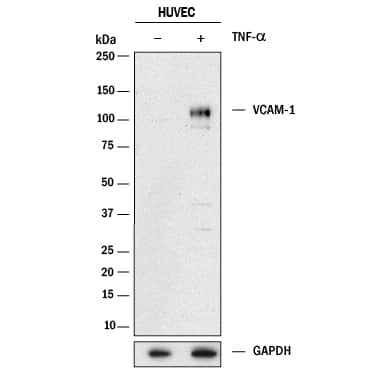Human VCAM-1/CD106 Antibody
R&D Systems, part of Bio-Techne | Catalog # MAB8091


Conjugate
Catalog #
Key Product Details
Species Reactivity
Human
Applications
CyTOF-ready, Flow Cytometry, Immunohistochemistry, Simple Western, Western Blot
Label
Unconjugated
Antibody Source
Monoclonal Mouse IgG1 Clone # 1027433
Product Specifications
Immunogen
Chinese Hamster Ovary cell line CHO-derived human VCAM-1/CD106
Phe25-Glu698
Accession # P19320-1
Phe25-Glu698
Accession # P19320-1
Specificity
Detects human VCAM-1/CD106 in direct ELISAs.
Clonality
Monoclonal
Host
Mouse
Isotype
IgG1
Scientific Data Images for Human VCAM-1/CD106 Antibody
Detection of Human VCAM-1/CD106 by Western Blot.
Western blot shows lysates of HUVEC human umbilical vein endothelial cells untreated (-) or treated (+) with 10 ng/mL Recombinant Human TNF-alpha (210-TA) for 24 hours. PVDF membrane was probed with 2 µg/mL of Mouse Anti-Human VCAM-1/CD106 Monoclonal Antibody (Catalog # MAB8091) followed by HRP-conjugated Anti-Mouse IgG Secondary Antibody (HAF018). A specific band was detected for VCAM-1/CD106 at approximately 110 kDa (as indicated). GAPDH (MAB5718) is shown as a loading control. This experiment was conducted under reducing conditions and using Western Blot Buffer Group 1.Detection of VCAM‑1/CD106 in HuT 78 Human Cell Line by Flow Cytometry.
HuT 78 human cutaneous T cell lymphoma cell line was stained with Mouse Anti-Human VCAM-1/CD106 Monoclonal Antibody (Catalog # MAB8091, filled histogram) or isotype control antibody (MAB002, open histogram) followed by anti-Mouse IgG PE-conjugated Secondary Antibody (F0102B). Staining was performed using our Staining Membrane-associated Proteins protocol.VCAM-1/CD106 in Human Spleen.
VCAM-1/CD106 was detected in immersion fixed paraffin-embedded sections of human spleen using Mouse Anti-Human VCAM-1/CD106 Monoclonal Antibody (Catalog # MAB8091) at 5 µg/mL for 1 hour at room temperature followed by incubation with the Anti-Mouse IgG VisUCyte™ HRP Polymer Antibody (VC001). Before incubation with the primary antibody, tissue was subjected to heat-induced epitope retrieval using Antigen Retrieval Reagent-Basic (CTS013). Tissue was stained using DAB (brown) and counterstained with hematoxylin (blue). Specific staining was localized to splenocytes. Staining was performed using our protocol for IHC Staining with VisUCyte HRP Polymer Detection Reagents.Applications for Human VCAM-1/CD106 Antibody
Application
Recommended Usage
CyTOF-ready
Ready to be labeled using established conjugation methods. No BSA or other carrier proteins that could interfere with conjugation.
Flow Cytometry
0.25 µg/106 cells
Sample: HuT 78 human cutaneous T cell lymphoma cell line
Sample: HuT 78 human cutaneous T cell lymphoma cell line
Immunohistochemistry
5-25 µg/mL
Sample: Immersion fixed paraffin-embedded sections of human splee
Sample: Immersion fixed paraffin-embedded sections of human splee
Simple Western
20 µg/mL
Sample: HUVEC human umbilical vein endothelial cells
Sample: HUVEC human umbilical vein endothelial cells
Western Blot
2 µg/mL
Sample: HUVEC human umbilical vein endothelial cells treated with Recombinant Human TNF‑ alpha, Catalog # 210-TA
Sample: HUVEC human umbilical vein endothelial cells treated with Recombinant Human TNF‑ alpha, Catalog # 210-TA
Reviewed Applications
Read 1 review rated 5 using MAB8091 in the following applications:
Formulation, Preparation, and Storage
Purification
Protein A or G purified from hybridoma culture supernatant
Reconstitution
Reconstitute at 0.5 mg/mL in sterile PBS. For liquid material, refer to CoA for concentration.
Formulation
Lyophilized from a 0.2 μm filtered solution in PBS with Trehalose. *Small pack size (SP) is supplied either lyophilized or as a 0.2 µm filtered solution in PBS.
Shipping
Lyophilized product is shipped at ambient temperature. Liquid small pack size (-SP) is shipped with polar packs. Upon receipt, store immediately at the temperature recommended below.
Stability & Storage
Use a manual defrost freezer and avoid repeated freeze-thaw cycles.
- 12 months from date of receipt, -20 to -70 °C as supplied.
- 1 month, 2 to 8 °C under sterile conditions after reconstitution.
- 6 months, -20 to -70 °C under sterile conditions after reconstitution.
Background: VCAM-1/CD106
References
- Vonderheide, R.H. et al. (1994) J. Cell Biol. 125:215.
- Cybulsky, M.I. et al. (1991) Proc. Natl. Acad. Sci. USA 88:7859.
- Luster, A.D. et al. (2005) Nat. Immunol. 6:1182.
- Osborn, L. et al. (1989) Cell 59:1203
- Langer. H.F. et al. 2009. J Cell Mol Med. 13:1211.
- Willeit.K. et al. 2017. JAMA Cardiol. 2:516.
- Lo Iacono.O. et al. 2008. Liver Int. 28:1129.
- Wu.T.C. et al. 2007. Cancer Research. 67:6003
Long Name
Vascular Cell Adhesion Molecule 1
Alternate Names
CD106, VCAM1
Gene Symbol
VCAM1
UniProt
Additional VCAM-1/CD106 Products
Product Documents for Human VCAM-1/CD106 Antibody
Product Specific Notices for Human VCAM-1/CD106 Antibody
For research use only
